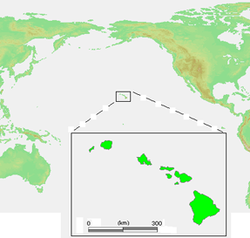Republic of Hawaii
| Republic of Hawaii | ||||||||||||
| Lepupalika ʻo Hawaiʻi | ||||||||||||
|
||||||||||||
|
||||||||||||
|
Motto Ua Mau ke Ea o ka ʻĀina i ka Pono |
||||||||||||
|
Anthem "Hawaiʻi Ponoʻī" |
||||||||||||
|
Republic of Hawaii
|
||||||||||||
| Capital | Honolulu | |||||||||||
| Languages | English, Hawaiian | |||||||||||
| Government |
Republic One-party state |
|||||||||||
| President | Sanford B. Dole | |||||||||||
| History | ||||||||||||
| • | Established | July 4, 1894 | ||||||||||
| • | Annexed by the US | August 12, 1898 | ||||||||||
| Area | ||||||||||||
| • | 1896 | 16,703 km² (6,449 sq mi) | ||||||||||
| Population | ||||||||||||
| • | 1896 est. | 109,020 | ||||||||||
| Density | 6.5 /km² (16.9 /sq mi) | |||||||||||
| Currency |
Hawaiian dollar U.S. dollar |
|||||||||||
|
||||||||||||
| Today part of |
|
|||||||||||
The Republic of Hawaiʻi was the formal name of the nation of Hawaiʻi between July 4, 1894, when the Provisional Government of Hawaii ended, and August 12, 1898, when it was annexed by the United States as a territory of the United States. The Territory of Hawaii was formally established as part of the U.S. on June 14, 1900.
The Kingdom of Hawaii was overthrown in 1893 in a bloodless revolt against a Queen who rejected the constitution then in effect. American officials immediately recognized the new government and U.S. Marines landed to protect American citizens during the upheaval. The Queen's supporters charged their presence frightened the Queen and thus enabled the revolution. The new Republic of Hawaii was led by men of European ancestry, like Sanford B. Dole and Lorrin A. Thurston, who were native-born subjects of the Hawaiian kingdom and speakers of the Hawaiian language, but had strong financial, political, and family ties to the United States. Dole was a former member of the Kingdom legislature from Koloa, Kauai, and Justice of the Kingdom's Supreme Court, and he appointed Thurston—who had served as Minister of Interior under King Kalākaua—to lead a lobbying effort in Washington, DC to secure Hawaii's annexation by the United States.
The Reform Party of Hawaii forced the King to accept the 1887 Constitution of the Kingdom of Hawaii that ended his absolute rule and provided for constitutional government. The 1893 coup d'état carried out by more than 1,000 armed local men. There was no bloodshed as the royal armed force did not resist. A temporary Provisional Government of Hawaii was formed by the Committee of Safety. They wanted to join the United States. S. Annexation was delayed by two petitions with over 20,000 signatures representing over half of the Native Hawaiian population. (see it at http://libweb.hawaii.edu/digicoll/annexation/petition.html ). The Queen herself took up residence in Washington, to lobby for her restoration. President Grover Cleveland, a Democrat opposed to American expansion, sent an investigator who wrote the Blount Report. The report concluded that Minister Stevens had manipulated and orchestrated the revolt. Cleveland decided that the United States should restore the Queen; he asked for Dole's resignation. Dole ignored it. The U.S. Senate held hearings regarding the Morgan Report, undermining the Blount Report's claims. Public opinion in the United States favored annexation. In May 1894 the U.S. Senate unanimously passed a resolution opposing restoration of the Queen, opposing intrusion into the affairs of the Dole government, and opposing American action that could lead immediately to annexation. President Cleveland thereupon dropped the issue, leaving the Republic of Hawaii to fend for itself.
...
Wikipedia



